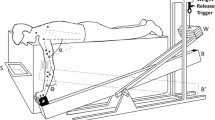Summary
Tonic neck reflexes (TNR) are often assumed to be included in the building of voluntary motor programmes. The present study was designed to test the importance of TNR in the performance by healthy human adults of high level dynamic exercise. The subjects were placed in an experimental situation similar to the original one used by previous authors, but in a fixed restrained posture. They repeatedly lifted weights by extending the elbow, with the head rotated either towards the side of the active upper limb or towards the opposite side. The rate of movement was 0.5 Hz, and the initial amplitude 60°. Successive series of 15 movements separated by an equivalent period of rest were made by each subject until exhaustion. The mechanical work performed during each series of movements was calculated. Surface electromyograms (EMG) from triceps brachii, anconeus, and biceps brachii muscles were recorded simultaneously with the elbow rotation displacement and then integrated. The EMG from the sterno-cleïdo-mastoidei muscles were also recorded. With successive series of lifting, movement amplitude decreased progressively as a result of fatigue. Thus there was a decrease in the work performed. In agreement with the experimental data of the previous authors as well as with the expected effect of TNR, the decrease in work was less marked when the subjects kept their heads turned towards their moving limb. However, in contrast with the results from other authors, the facilitation was very low. From these results, we concluded that TNR can slightly influence the amount of work that a subject can produce. Nonetheless direct facilitation exerted by TNR on the prime mover muscles is lower than the one exerted through facilitating postures.
Similar content being viewed by others
References
Aiello I, Rosati G, San GF, Patraskakis S, Bissakou M, Traccis S (1988) Tonic neck reflexes on upper limb flexor tone in man. Exp Neurol 101:41–49
Brookhart JM (1979) Convergence on an understanding motor control. In: Talbott RE, Humphrey DR (eds) Posture and movement. Raven Press, New York, pp 295–303
Brooks VB (1986) Postural control. In: Brooks VB (ed) The neural basis of motor control. Oxford University Press, Oxford, pp 160–180
De Luca CJ (1984) Myoelectrical manifestations of localized fatigue in humans. CRC Crit Rev Biomed Eng 11:251–279
Fukuda T (1961) Studies on human dynamic postures from the viewpoint of postural reflexes. Acta otolaryngol (Stockh) 161:1–52
Gesell A (1938) The tonic neck reflex in the human infant. J Pediatr 13:455–464
Hagberg M (1981) Work load and fatigue in repetitive arm elevations. Ergonomics 24:543–555
Hellebrandt FA, Waterland JC (1962) Expansion of motor patterning under exercise stress. Am J Phys Med 41:56–66
Hellebrandt FA, Houtz SJ, Partridge MJ, Walters CE (1956) Tonic neck reflexes in exercices of stress in man. Am J Phys Med 35:144–159
Keele SW (1981) Behavioral analysis of movement. In: Brookhart M, Mountcastle VB (eds) Handbook of physiology, section I. The nervous system, vol II. Williams and Wilkins, Baltimore, pp 1391–1414
Lee WA (1984) Neuromotor synergies as a basis for coordinated intentional action. J Mot Behav 16:135–170
Lippold OCJ, Redfearn JWT, Vuco J (1957) The rhythmical activity of groups of motor units in the voluntary contraction of muscle. J Physiol (Lond) 137:473–487
Lippold OCJ, Redfearn JWT, Vuco J (1960) The electromyography of fatigue. Ergonomics 3:121–131
Magnus R, De Kleijn A (1912) Die Abhängigkeit des Tonus der Extremitäten-Muskeln von der Kopfstellung. Pflügers Arch 145:455–548
Maton B (1991) Central nervous changes in fatigue induced by local work. In: Atlan G, Beliveau L, Bouissou P (eds) Muscle fatigue, biochemical and physiological aspects. Masson, Paris, pp 207–221
Manzoni D, Pompeiano O, Stampacchia G (1979a) Tonic cervical influences on posture and reflex movements. Arch Ital Biol 117 2:81–110
Manzoni D, Pompeiano O, Stampacchia G (1979b) Cervical control of posture and movements. Brain Res 169:615–619
Minkowski M (1921) Sur les mouvements, les réflexes et les réactions musculaires du foetus humain de 2 à 5 mois et leurs relations avec le système nerveux feotal. Rev Neurol (Paris) 37:1105–1250
Monod H, Scherrer J (1965) The work capacity of a synergic muscular group. Ergonomics 8:329–338
Rohmert W (1960) Ermittlung von Erholungspausen für statische Arbeit des Menschen. Inn Z angew Physiol 18:123–164
Rossi A, Rossi B, Santarcangelo E (1985) Influences of neck vibration on lower limb extensor muscles in man. Arch Ital Biol 123:241–253
Rossi A, Mazzochio R, Nuti D (1986) Tonic neck influences on lower limb extensor motoneurone in man. Electromyogr Clin Neurophysiol 26:207–216
Rossi A, Mazzochio R, Mondelli M, Scarpini C (1987) Postural neck reflexes involving the lower limb extensor motoneurons in man. Electromyogr Clin Neurophysiol 27:195–201
Scherrer J, Monod H (1960) Le travail musculaire local et la fatigue chez l'homme. J Physiol (Paris) 52:419–501
Thoden U, Wenzel V (1979) Tonic cervical influences on forelimb and hindlimb monosynaptic reflexes. In: Granit R, Pompeiano O (eds) Reflex control of posture and movement. Prog Brain Res 50:281–288
Tokizane T, Murao M, Ogata T, Kondo T (1951) Electromyographic studies on tonic neck, lumbar and labyrinthine reflexes in normal persons. Jpn J Physiol 2:130–146
Traccis S, Rosatti G, Patraskakis S, Bissakou M, Sau GF, Aiello I (1987) Influences of neck receptors on soleus motoneuron excitability in man. Exp Neurol 45:76–84
Wachholder K (1923) Untersuchungen über die Innervation und Koordination der Bewegungen mit Hilfe der Aktionsströme. II. Mitteilung. Die Koordination der Agonisten und Antagonisten bei der menschlichen Bewegung. Pflügers Arch 199:625–650
Waterland JC, Hellebrandt FA (1964) Involuntary patterning associated with willed movement performed against progressively increasing resistance. Am J Physiol Med 43:13–30
Author information
Authors and Affiliations
Rights and permissions
About this article
Cite this article
Le Pellec, A., Maton, B. The influence of tonic neck reflexes on voluntary fatiguing elbow movements in humans. Europ. J. Appl. Physiol. 67, 231–238 (1993). https://doi.org/10.1007/BF00864221
Accepted:
Issue Date:
DOI: https://doi.org/10.1007/BF00864221



